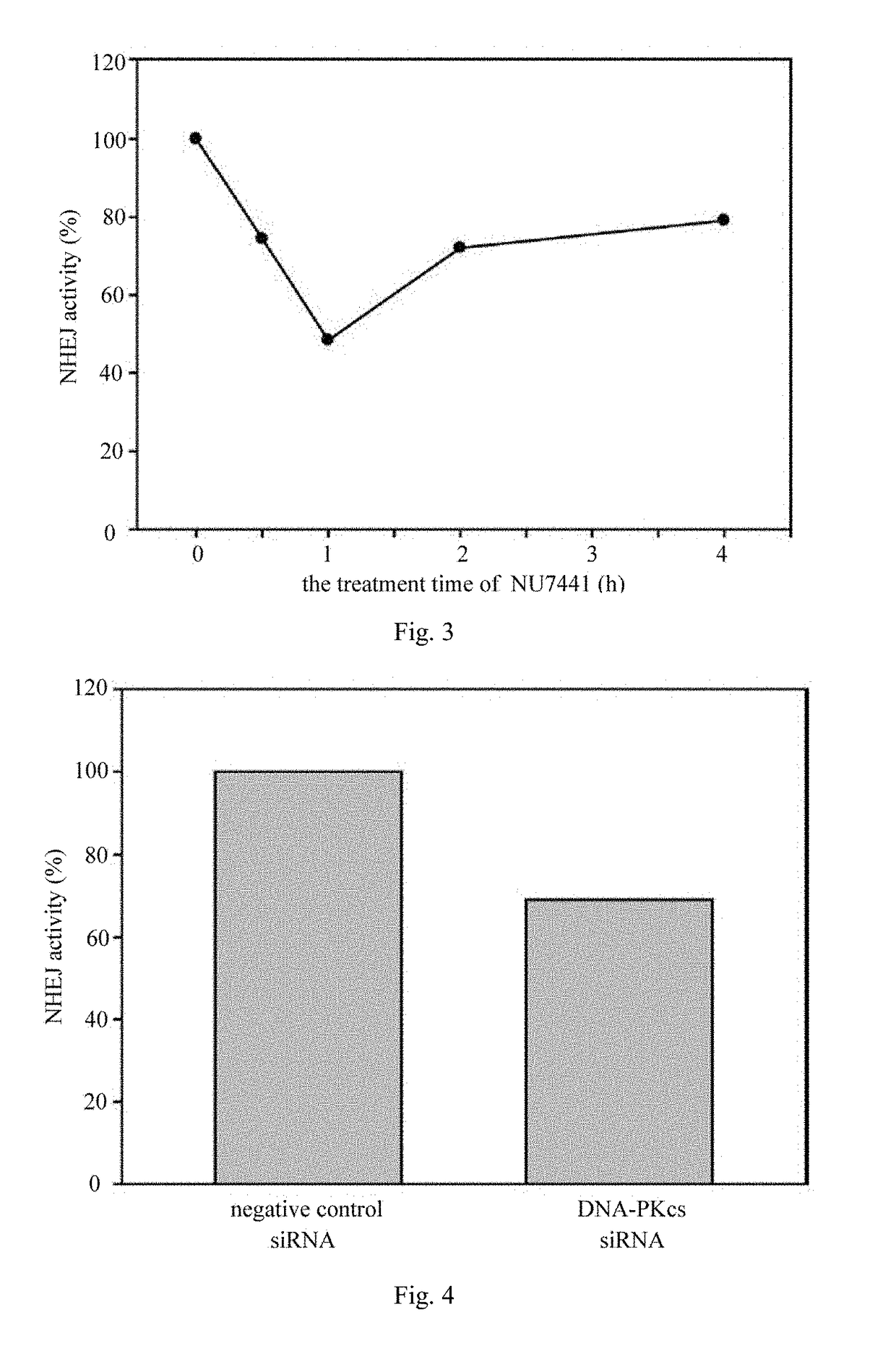Method for Determining the Repair Activity of Non-Homologous End Joining
a non-homologous end and repair activity technology, applied in the field of molecular biology, can solve the problems of complex repair system, loss of gene function, damage to cell genome, etc., and achieve the effect of enhancing sensitivities to chemotherapy and radiotherapy
- Summary
- Abstract
- Description
- Claims
- Application Information
AI Technical Summary
Benefits of technology
Problems solved by technology
Method used
Image
Examples
embodiment 1
[0030]The inhibiting effects of different concentrations of NU7441 on NHEJ are determined by using the TALEN technology, and the specific steps are as follows:
[0031](1) a TALEN plasmid for HPRT gene was constructed. The specific steps comprise: a left-arm recognition sequence ATGACCTTGATTTA (SEQ ID NO:1) and a right-arm recognition sequence CCAAATCCTCAGCA (SEQ ID NO:2) of the target HPRT gene were designed according to the TALEN design principle, and the two recognition sequences were inserted into a corresponding backbone carrier according to the method indicated on the TALEN construction kit. Competent E. coli cells were transformed with the carrier, uniformly spread on a kanamycin-resistant (20 μg / ml) plate and cultured in an incubator at 37° C. for 12-16 h, then 3-5 clones were selected and inoculated in 5 ml LB culture solution (containing 20 μg / ml kanamycin), and cultured in a shaker at 250 rpm under 37° C. for 16 h, plasmids were extracted and sequenced, and the obtained sequ...
embodiment 2
[0037]The time dependence of the inhibiting effect of 2.0 μmol / L NU7441 on NHEJ was determined by using the CRISPR / Cas9 technology, specific steps were as follows:
[0038](1) a Cas9 / gRNA plasmid was constructed for HPRT gene. The specific steps comprise: a target site primer of HPRT was designed according to a gRNA design principle, wherein the forward primer is AAACACCGAAAGGGTGTTTATTCCTCA (SEQ ID NO:3), and the reverse primer is CTCTAAAACTGAGGAATAAACACCCTTT (SEQ ID NO:4). The primers were annealed to form a dimer, and the gRNA-sequence primer dimer was inserted into a Cas9 / gRNA plasmid according to the method indicated on the CRISPR / Cas9 construction kit. Competent E. coli cells were transformed with the plasmid, spread on an ampicillin-resistant plate. 3-5 clones were selected and cultured in a shaker, plasmids were extracted and sequenced, and the obtained sequences were compared with the designed recognition sequences, ensuring the Cas9 / gRNA plasmids with correct sequences were ob...
embodiment 3
[0044]The inhibiting effect of DNA-PKcs siRNA on NHEJ was determined by using a CRISPR / Cas9 technology, and the specific steps comprise:
[0045](1) a Cas9 / gRNA plasmid was constructed for HPRT gene, and the specific steps are as described in the embodiment 2.
[0046](2) the Cas9 / gRNA plasmid and DNA-PKcs siRNA were co-transfected into 293T cells. The specific steps comprise: 293T cells were inoculated into a culture dish of 6 cm, and 3 μg Cas9 / gRNA plasmid and 3 μg DNA-PKcs siRNA were co-transfected into the 293T cells by using Lipofectamine 3000 when cell density reached 70%, and a negative control siRNA was transfected for the negative control group. The gene sequence of DNA-PKcs siRNA was UUCUCCGAACGUGUCACGUTT (SEQ ID NO:5).
[0047](3) the cells were treated with 6-TG. The specific steps comprise: the cells were inoculated into a 96-well plate after the transfection is performed for 24 h, then the culture medium was replaced with a DMEM culture medium containing 30 μmol / L 6-TG after ce...
PUM
| Property | Measurement | Unit |
|---|---|---|
| Fraction | aaaaa | aaaaa |
| Density | aaaaa | aaaaa |
| Cell viability | aaaaa | aaaaa |
Abstract
Description
Claims
Application Information
 Login to View More
Login to View More - R&D
- Intellectual Property
- Life Sciences
- Materials
- Tech Scout
- Unparalleled Data Quality
- Higher Quality Content
- 60% Fewer Hallucinations
Browse by: Latest US Patents, China's latest patents, Technical Efficacy Thesaurus, Application Domain, Technology Topic, Popular Technical Reports.
© 2025 PatSnap. All rights reserved.Legal|Privacy policy|Modern Slavery Act Transparency Statement|Sitemap|About US| Contact US: help@patsnap.com


